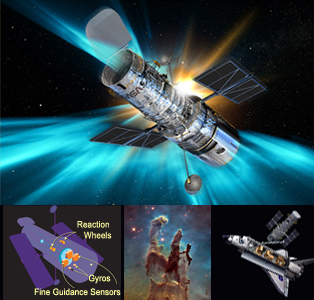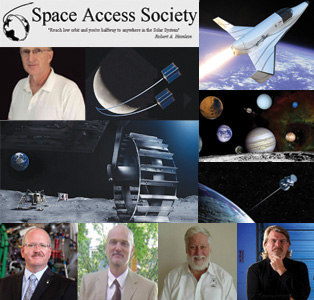Hubble Space Telescope Starts 26th Year of Cutting Edge Exploration
Currently generating about 844 gigabytes of data per month, totaling more than 100 terabytes of information used in over 11,000 scientific papers to date, Hubble is one of the most productive scientific instruments ever built. Funding of the joint NASA-ESA project is expected to continue at least until the succeeding James Webb Space Telescope becomes operational NET 2018. Regardless of instrument health and funding, final orbital decay is expected 2030-2040, depending on solar activity and resulting fluctuations of atmospheric drag. The observatory maintains a circular orbit of about 560km altitude and has pointing accuracy sufficient to hold a target to less than 7/1,000th of an arc second deviation while the spacecraft is moving at 7,160 meters per second. Over 38,000 celestial objects have been imaged, revealing new aspects of subjects as profound as the age of the Universe and as mysterious as dark energy and black holes. Events commemorating the 25th Anniversary of Hubble, deployed by STS-31 Discovery and astronomer astronaut Steven Hawley of the Ad Astra State of Kansas on April 25, 1990, bring into focus the transformative power of astronomy to enhance human understanding and imagination. NASA Administrator Charlie Bolden and Associate Administrator for Science John Grunsfeld, and Hubble Senior Project Scientist Jennifer Wiseman will preside over the presentation of the Hubble 25th Anniversary image on April 23 in Washington DC. One of many events celebrating the mission, which will also be featured at the Smithsonian’s National Air and Space Museum throughout April.(Image Credit: ESA/Hubble; NASA, ESA, Hubble Heritage Team, STSciI, AURA)
|
MONDAY
|

![]() = All times for terrestrial events in local time unless noted.
= All times for terrestrial events in local time unless noted.
![]() = All times for international terrestrial events in local time unless noted.
= All times for international terrestrial events in local time unless noted.
![]() = All times for space events, and…
= All times for space events, and…
![]() = All times for international space / astro events in Hawaii Standard Time unless noted. Add 10 hours to obtain UT (‘Universal Time;’ Greenwich, England).
= All times for international space / astro events in Hawaii Standard Time unless noted. Add 10 hours to obtain UT (‘Universal Time;’ Greenwich, England).
Weekly Planet Watch – Evening Planets: Mercury (W), Venus (W), Mars (W), Jupiter (S); Morning Planets: Saturn (S).
Space Access Society Supporting Private / Public Low-Cost Space Ventures
|
Continued from…
TUESDAY
|
![]() Apr 21-22 — The National Academies, Irvine CA: Meeting: Review of Spacecraft Exposure Guidelines for Air and Water Contaminants.
Apr 21-22 — The National Academies, Irvine CA: Meeting: Review of Spacecraft Exposure Guidelines for Air and Water Contaminants.
![]() Apr 21 — Moon: 1.5° NE of Aldebaran, 07:00; 6.6° S of Venus, 09:00.
Apr 21 — Moon: 1.5° NE of Aldebaran, 07:00; 6.6° S of Venus, 09:00.
![]() Apr 21 — Asteroid 2015 BY310: Near-Earth flyby (0.088 AU).
Apr 21 — Asteroid 2015 BY310: Near-Earth flyby (0.088 AU).
WEDNESDAY
![]() Apr 22 — Earth Day Network, Worldwide: Earth Day 2015; to broaden, diversify & activate the environmental movement worldwide.
Apr 22 — Earth Day Network, Worldwide: Earth Day 2015; to broaden, diversify & activate the environmental movement worldwide.
![]() Apr 22, 23 — Wichita State University, Wichita KS: Les Johnson presents “Propellantless propulsion: Propelling spacecraft using the natural environments of space” & “Using space science and technology to help solve energy and environmental problems on Earth.”
Apr 22, 23 — Wichita State University, Wichita KS: Les Johnson presents “Propellantless propulsion: Propelling spacecraft using the natural environments of space” & “Using space science and technology to help solve energy and environmental problems on Earth.”
![]() Apr 22-23 — The National Academies, Washington DC: Space Studies Board Meeting.
Apr 22-23 — The National Academies, Washington DC: Space Studies Board Meeting.
![]() Apr 22 — Lyrids Meteor Shower Peak: This shower can produce about 15-20 meteors per hour, appearing near Vega above northeast horizon, peak 14:00.
Apr 22 — Lyrids Meteor Shower Peak: This shower can produce about 15-20 meteors per hour, appearing near Vega above northeast horizon, peak 14:00.
![]() Apr 22 — Moon: 6.1° S of M35, 22:00.
Apr 22 — Moon: 6.1° S of M35, 22:00.
![]() Apr 22 — Mercury: 1.3° NNW of Mars, 10:00.
Apr 22 — Mercury: 1.3° NNW of Mars, 10:00.
THURSDAY
![]() Apr 23 — NASA, Washington DC: Hubble 25th anniversary image to be revealed at Newseum, 09:00-09:45; featuring NASA Administrator Charlie Bolden, Associate Administrator for Science Mission Directorate John Grunsfeld, Hubble Senior Project Scientist Jennifer Wiseman.
Apr 23 — NASA, Washington DC: Hubble 25th anniversary image to be revealed at Newseum, 09:00-09:45; featuring NASA Administrator Charlie Bolden, Associate Administrator for Science Mission Directorate John Grunsfeld, Hubble Senior Project Scientist Jennifer Wiseman.
![]() Apr 23 — Kealakehe Elementary School, Kailua-Kona HI: 1st Annual Science Night; featuring talks by IFA-Hilo, CFHT, Jon Lomberg.
Apr 23 — Kealakehe Elementary School, Kailua-Kona HI: 1st Annual Science Night; featuring talks by IFA-Hilo, CFHT, Jon Lomberg.
![]() Apr 23, 24 — Jet Propulsion Laboratory, Caltech/NASA, Pasadena CA: von Kármán Lecture Series: Robots to the Rescue!: JPL’s RoboSimian and Surrogate Robots are here to Help; presented by Brett Kennedy of JPL.
Apr 23, 24 — Jet Propulsion Laboratory, Caltech/NASA, Pasadena CA: von Kármán Lecture Series: Robots to the Rescue!: JPL’s RoboSimian and Surrogate Robots are here to Help; presented by Brett Kennedy of JPL.
![]() Apr 23 — Pi Puppids Meteor Shower Peak: This shower can produce up to 38 meteors per hour, appearing near Puppis in a southerly radiant, peak 19:00.
Apr 23 — Pi Puppids Meteor Shower Peak: This shower can produce up to 38 meteors per hour, appearing near Puppis in a southerly radiant, peak 19:00.
FRIDAY
![]() Apr 24 — Hubble, LEO: NASA spacecraft with 2.4-meter diameter main telescope reaches 25 years in space today, launched Apr 24, 1990; expected to continue operations until at least 2021.
Apr 24 — Hubble, LEO: NASA spacecraft with 2.4-meter diameter main telescope reaches 25 years in space today, launched Apr 24, 1990; expected to continue operations until at least 2021.
![]() Apr 24 — MESSENGER OCM-17, Mercury Orbit: Only spacecraft at Mercury to perform Orbital Correction Maneuver #17 today; expected to impact surface this month / end mission; launched Aug 2004.
Apr 24 — MESSENGER OCM-17, Mercury Orbit: Only spacecraft at Mercury to perform Orbital Correction Maneuver #17 today; expected to impact surface this month / end mission; launched Aug 2004.
![]() Apr 24 — SpaceX, Launch Falcon 9 / TurkmenAlem52E/MonacoSat 1, Cape Canaveral AFS FL: SpaceX Falcon 9 rocket to launch TurkmenAlem52E / MonacoSat 1 communications satellite for Thales Alenia Space & Turkmenistan government.
Apr 24 — SpaceX, Launch Falcon 9 / TurkmenAlem52E/MonacoSat 1, Cape Canaveral AFS FL: SpaceX Falcon 9 rocket to launch TurkmenAlem52E / MonacoSat 1 communications satellite for Thales Alenia Space & Turkmenistan government.
![]() Apr 24 — Rotary Award for Space Achievement (RNASA) Foundation, Houston TX: 2015 RNASA Space Awards Gala; 2015 National Space Trophy to be awarded to Col. Robert Cabana, Kennedy Space Center Director & former NASA Astronaut on 4 space shuttle missions.
Apr 24 — Rotary Award for Space Achievement (RNASA) Foundation, Houston TX: 2015 RNASA Space Awards Gala; 2015 National Space Trophy to be awarded to Col. Robert Cabana, Kennedy Space Center Director & former NASA Astronaut on 4 space shuttle missions.
![]() Apr 24 — Goddard Space Flight Center, NASA, Greenbelt MD: Colloquium: Hubble and the Extravagant Universe; presented by Robert Kirshner of Harvard University.
Apr 24 — Goddard Space Flight Center, NASA, Greenbelt MD: Colloquium: Hubble and the Extravagant Universe; presented by Robert Kirshner of Harvard University.
![]() Apr 24 — The Space Show, Online / Tiburon CA: Dr. David Livingston talks with Dr. Guillem Anglada-Escudé from Queen Mary University of London about exoplanet GJ581d.
Apr 24 — The Space Show, Online / Tiburon CA: Dr. David Livingston talks with Dr. Guillem Anglada-Escudé from Queen Mary University of London about exoplanet GJ581d.
![]() Apr 24 — Moon: 11.8° S of Pollux, 15:00.
Apr 24 — Moon: 11.8° S of Pollux, 15:00.
SATURDAY
![]() Apr 25 — The Astronomical League, Worldwide: Astronomy Day; astronomy planetariums, museums, observatories will sponsor public viewing sessions & activities to increase awareness about astronomy & the Universe.
Apr 25 — The Astronomical League, Worldwide: Astronomy Day; astronomy planetariums, museums, observatories will sponsor public viewing sessions & activities to increase awareness about astronomy & the Universe.
![]() Apr 25 — Ad Astra Kansas Foundation, Topeka KS: 13th Annual Ad Astra Kansas Day 2015 Space Celebration: To Pluto and Beyond; at Stoffer Science Hall of Washburn University.
Apr 25 — Ad Astra Kansas Foundation, Topeka KS: 13th Annual Ad Astra Kansas Day 2015 Space Celebration: To Pluto and Beyond; at Stoffer Science Hall of Washburn University.
![]() Apr 25 — Moon: At first quarter, 13:55; 0.94° W of asteroid 3 Juno, 19:00; 5.9° SSW of Beehive Cluster, 19:00.
Apr 25 — Moon: At first quarter, 13:55; 0.94° W of asteroid 3 Juno, 19:00; 5.9° SSW of Beehive Cluster, 19:00.
SUNDAY
![]() Apr 26 – May 1 — American Astronomical Society Solar Physics Division, Indianapolis IN: 1st Joint Meeting: AAS Solar Physics Division/AGU Space Physics and Aeronomy Section.
Apr 26 – May 1 — American Astronomical Society Solar Physics Division, Indianapolis IN: 1st Joint Meeting: AAS Solar Physics Division/AGU Space Physics and Aeronomy Section.
![]() Apr 26 — Moon: 5.3° SSW of Jupiter, 06:00.
Apr 26 — Moon: 5.3° SSW of Jupiter, 06:00.

 The Space Access Society will be hosting its Space Access 2015 Conference in Phoenix, Arizona on April 30 – May 2 at the Radisson Hotel Phoenix North. The conference will feature more than 21 hours on current and future technologies, businesses and politics of cheaper space transportation. There will be a special session on ‘Return to the Moon’ by Doug Plata who is proposing to use the successful Commercial Cargo transportation model to facilitate lunar commercial development, transportation and habitation. This session will also feature talks by Jeff Greason (market implication of lunar return), Pascal Lee (the Moon and the road to Mars), Dave Masten (on low-cost access to lunar surface) and Erik Seedhouse (lunar surface crew factors and habitats). Also presenting during the conference will be Jon Goff (Altius Space Machines), Jeff Foust (The Space Review), Clark Lindsey (NewSpace Global), Doug Messier (Parabolic Arc), Ben Brockert (Moon Express), Gary Hudson (Space Studies Institute), Peter Swan (International Space Elevator Consortium) and Ed Wright (Citizens in Space). Henry Vanderbilt (Top), Executive Director and Founder of SAS 1992, continues to organize the annual conference and contribute to the long-standing Space Access Updates. (Image Credit: SAS, XCOR, Masten, GLXP, NASA, JPL)
The Space Access Society will be hosting its Space Access 2015 Conference in Phoenix, Arizona on April 30 – May 2 at the Radisson Hotel Phoenix North. The conference will feature more than 21 hours on current and future technologies, businesses and politics of cheaper space transportation. There will be a special session on ‘Return to the Moon’ by Doug Plata who is proposing to use the successful Commercial Cargo transportation model to facilitate lunar commercial development, transportation and habitation. This session will also feature talks by Jeff Greason (market implication of lunar return), Pascal Lee (the Moon and the road to Mars), Dave Masten (on low-cost access to lunar surface) and Erik Seedhouse (lunar surface crew factors and habitats). Also presenting during the conference will be Jon Goff (Altius Space Machines), Jeff Foust (The Space Review), Clark Lindsey (NewSpace Global), Doug Messier (Parabolic Arc), Ben Brockert (Moon Express), Gary Hudson (Space Studies Institute), Peter Swan (International Space Elevator Consortium) and Ed Wright (Citizens in Space). Henry Vanderbilt (Top), Executive Director and Founder of SAS 1992, continues to organize the annual conference and contribute to the long-standing Space Access Updates. (Image Credit: SAS, XCOR, Masten, GLXP, NASA, JPL)